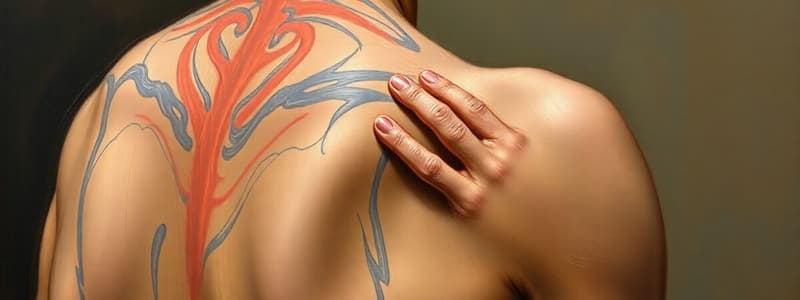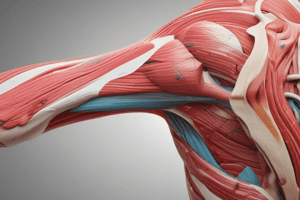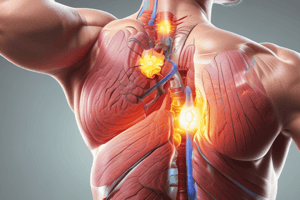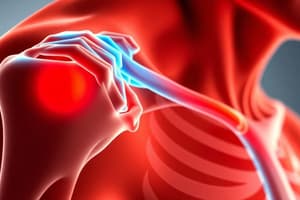Podcast
Questions and Answers
What is the most prevalent intrinsic cause of shoulder pain in adults over the age of 70?
What is the most prevalent intrinsic cause of shoulder pain in adults over the age of 70?
- Shoulder impingement syndrome
- Rotator cuff disorders (correct)
- Frozen shoulder
- Shoulder instability
Which factor is least likely to be considered a risk factor for shoulder pain?
Which factor is least likely to be considered a risk factor for shoulder pain?
- Previous shoulder injuries
- Age over 30 years
- Regular shoulder exercise (correct)
- Cervical spine disease
In managing shoulder conditions, what is a crucial step before referring a patient for specialist care?
In managing shoulder conditions, what is a crucial step before referring a patient for specialist care?
- Debrief the patient's family about the condition
- Conduct a physical examination of the shoulder (correct)
- Perform imaging studies immediately
- Administer pain relief medication
What type of pain refers to the shoulder but originates from the cervical spine?
What type of pain refers to the shoulder but originates from the cervical spine?
Which imaging finding is most critical in diagnosing acute shoulder injuries?
Which imaging finding is most critical in diagnosing acute shoulder injuries?
What typical symptom distinguishes intrinsic shoulder conditions from extrinsic causes?
What typical symptom distinguishes intrinsic shoulder conditions from extrinsic causes?
Which shoulder condition is characterized by a significant limitation in shoulder motion?
Which shoulder condition is characterized by a significant limitation in shoulder motion?
What should be the focus when developing a differential diagnosis for shoulder pain?
What should be the focus when developing a differential diagnosis for shoulder pain?
What is the primary difference between tendinopathy and tendonitis?
What is the primary difference between tendinopathy and tendonitis?
Which of the following conditions is least likely to cause extrinsic shoulder pain related to abdominal disorders?
Which of the following conditions is least likely to cause extrinsic shoulder pain related to abdominal disorders?
What percentage of patients reported having more than one diagnosis in the studied population regarding shoulder pain?
What percentage of patients reported having more than one diagnosis in the studied population regarding shoulder pain?
Which of the following statements regarding rotator cuff tears is true?
Which of the following statements regarding rotator cuff tears is true?
Which condition is NOT listed among the neurologic disorders that can cause extrinsic shoulder pain?
Which condition is NOT listed among the neurologic disorders that can cause extrinsic shoulder pain?
In which situation is it more likely that a rotator cuff tear will not heal?
In which situation is it more likely that a rotator cuff tear will not heal?
Which of the following does NOT contribute to vascular insufficiency related to shoulder pain?
Which of the following does NOT contribute to vascular insufficiency related to shoulder pain?
What significantly affects the quality of rotator cuff repair post-surgery?
What significantly affects the quality of rotator cuff repair post-surgery?
What is the primary symptom of rotator cuff disease (RCD) during overhead activities?
What is the primary symptom of rotator cuff disease (RCD) during overhead activities?
Which muscle's distribution is primarily associated with the shoulder pain in RCD?
Which muscle's distribution is primarily associated with the shoulder pain in RCD?
What does a painless loss of active motion indicate in the context of RCD?
What does a painless loss of active motion indicate in the context of RCD?
During physical examination for RCD, which area should also be inspected to check for referred pain?
During physical examination for RCD, which area should also be inspected to check for referred pain?
What findings during inspection could suggest a diagnosis of anterior dislocation?
What findings during inspection could suggest a diagnosis of anterior dislocation?
Which physical examination technique involves assessing signs of tenderness?
Which physical examination technique involves assessing signs of tenderness?
What should be noted during the inspection of shoulder motion?
What should be noted during the inspection of shoulder motion?
What condition could 'winging' of the scapula indicate during physical examination?
What condition could 'winging' of the scapula indicate during physical examination?
What is the positive likelihood ratio (LR) for the painful arc of abduction indicating subacromial impingement?
What is the positive likelihood ratio (LR) for the painful arc of abduction indicating subacromial impingement?
Which clinical test has the lowest specificity for diagnosing rotator cuff impingement?
Which clinical test has the lowest specificity for diagnosing rotator cuff impingement?
What does a positive Yocum test indicate?
What does a positive Yocum test indicate?
What is the negative likelihood ratio (LR) of the Hawkins test when both Hawkins and Neer signs are absent?
What is the negative likelihood ratio (LR) of the Hawkins test when both Hawkins and Neer signs are absent?
Which test is specifically designed to evaluate supraspinatus function through abduction?
Which test is specifically designed to evaluate supraspinatus function through abduction?
Which of the following tests has a specificity of 81%?
Which of the following tests has a specificity of 81%?
What does a positive test during the Neer impingement test indicate?
What does a positive test during the Neer impingement test indicate?
In the context of the Drop arm test, what is considered a positive result?
In the context of the Drop arm test, what is considered a positive result?
What is the primary reason early non-surgical interventions may be beneficial for patients with rotator cuff tendonitis?
What is the primary reason early non-surgical interventions may be beneficial for patients with rotator cuff tendonitis?
What percentage of partial thickness rotator cuff tears is expected to progress to full thickness tears within two years?
What percentage of partial thickness rotator cuff tears is expected to progress to full thickness tears within two years?
Which of the following statements is true regarding full thickness rotator cuff tears?
Which of the following statements is true regarding full thickness rotator cuff tears?
What is commonly seen in patients with larger rotator cuff tears?
What is commonly seen in patients with larger rotator cuff tears?
For which patient demographic is physical therapy especially indicated for rotator cuff tears?
For which patient demographic is physical therapy especially indicated for rotator cuff tears?
What is the expected outcome of surgical repair compared to physical therapy for rotator cuff tears over a long-term period?
What is the expected outcome of surgical repair compared to physical therapy for rotator cuff tears over a long-term period?
What factor negatively affects the prognosis for successful surgical treatment of rotator cuff tears?
What factor negatively affects the prognosis for successful surgical treatment of rotator cuff tears?
What is a likely consequence of untreated full thickness subscapularis tendon tears?
What is a likely consequence of untreated full thickness subscapularis tendon tears?
Flashcards are hidden until you start studying
Study Notes
Epidemiology of Shoulder Pain
- Shoulder pain is the third most common musculoskeletal reason for seeking medical care.
- Affecting between 7% and 26% of adults.
- Symptomatic rotator cuff disorders increase with age.
- 2.8% of people over 30 years old have rotator cuff disorders.
- 15% of people over 70 years old have rotator cuff disorders.
Intrinsic Causes
- Articular and periarticular structures, causing most shoulder complaints.
Extrinsic Causes
- Refer pain to the shoulder, involving neurological disorders or visceral conditions.
- Most common cause: Cervical spine disease.
Diagnostic Approach
- Distinguish between intrinsic and extrinsic causes.
- Shoulder pain increases with shoulder and arm movement for intrinsic causes.
Causes of Extrinsic Shoulder Pain
- Chest disorders: Myocardial infarction, angina pectoris, Pericarditis, Aortic dissection, Pulmonary embolism, Pneumothorax, Pneumonia, Pleuritis, Pancoast tumour, Mesothelioma, Mediastinal or lung neoplasm.
- Abdominal and pelvic disorders: Left shoulder pain - splenic infarction, splenic rupture. Right shoulder pain - Hepatic abscess, Cholecystitis, Hepatic hematoma. Left and/or right shoulder pain - subphrenic abscess, intra-abdominal hemorrhage, ruptured abdominal viscus.
- Neurologic disorders: Cervical radiculopathy, Brachial plexopathy, Entrapment neuropathy, Herpes zoster, Cervical spinal stenosis, Thoracic outlet syndrome.
- Esophageal disease: Aneurysm, Peptic ulcer, Pancreatitis, Abdominal neoplasms, Ectopic pregnancy.
- Vascular insufficiency including: Arteritis, Venous thrombosis.
Rotator Cuff Disease (RCD)
- Involves tendinopathy of the rotator cuff muscles, full- or partial-thickness tears of rotator cuff tendons, or subacromial bursitis.
- Tendinopathy is a broad term for conditions of the tendon causing swelling and pain.
- Tendinopathy and tendonitis are often used interchangeably.
- Majority of patients with RCD improve with non-operative treatment.
- Some patients with full-thickness rotator cuff tears can recover function with non-operative treatment.
- Smaller tears are less likely to propagate.
- Larger tears, tend to progress and may become irreparable due to tendon retraction, muscle atrophy, or both, or when tendon tissue quality does not allow repair.
- Shoulder and arm pain/weakness is the most common symptom, especially during overhead activities.
Clinical Presentation
- Pain often felt in the distribution of the deltoid muscle.
- Other symptoms include: night pain, weakness, stiffness, or crepitus heard during shoulder movement.
- Diagnosis of RCD does not require pain for chronic full-thickness rotator cuff tear.
Physical Examination
- Includes inspection, palpation, range of motion, strength, and provocative shoulder tests.
- Neck and elbow examination to rule out referred pain.
Inspection
- Observe how the patient moves and carries the shoulder.
- Note swelling, asymmetry, muscle atrophy, scars, ecchymosis, and venous distention.
- Venous distention may indicate venous thoracic outlet syndrome.
- Deformity (squaring of the shoulder or a step defect at the AC joint) could suggest a diagnosis.
- Scapular “winging” can be associated with shoulder instability and serratus anterior or trapezius dysfunction.
- Atrophy of the supraspinatus or infraspinatus may indicate rotator cuff tear, suprascapular nerve entrapment or neuropathy.
Palpation
- Acromioclavicular and sternoclavicular joints, cervical spine, and the biceps tendon.
- Anterior/posterior glenohumeral joint, coracoid process, acromion, and scapula should be palpated for tenderness and deformity.
Range of Motion Testing
- Complex series of articulations in the shoulder allow a wide range of motion.
- Compare the affected extremity with the unaffected side.
- Assess active and passive ranges of motion.
- Pain with adduction (positive test for AC joint involvement).
- Acromioclavicular joint tenderness and compression tenderness have low LRs.
Provocative Tests
- Neer impingement sign/test: Pain reproduced with full passive shoulder flexion.
- Painful arc of abduction: Shoulder pain from 60° to 120°.
- Hawkins impingement sign/test: Pain reproduced with the shoulder forward flexed 90 degrees, elbow flexed 90 degrees, and shoulder maximally internally rotated.
- Passive Abduction: Pain reproduced with passive shoulder abduction.
- Yocum Test: Pain with elbow elevation without raising the ipsilateral shoulder.
Strength Tests
- Drop arm test (supraspinatus): Immediate pain and patient drops arm as they are unable to lower it slowly.
- Dropping sign
- External rotation lag
- Internal rotation lag
- Gerber (lift off test)
Prognosis
- Partial rotator cuff tears may heal with non-operative treatment.
- 40% of partial thickness tears progress to full thickness tears within 2 years.
- Full thickness rotator cuff tears do not heal well and tend to increase in size.
- 49% of full thickness tears get bigger over an average of 2.8 years.
- Fatty infiltration is a degenerative process where muscle is replaced by fat, affecting the rotator cuff tendons.
- Fatty infiltration progresses in full thickness rotator cuff tears and a negative prognostic factor for successful surgical treatment.
- Fatty infiltration is an irreversible process: operative interventions performed when the degree of infiltration is low.
- Most young active patients with acute full thickness tears should be treated with operative fixation.
- Full thickness subscapularis tendon tears should undergo surgical repair.
- Physical therapy is indicated for atraumatic degenerative rotator cuff tears.
- Long term (10 year) outcome studies show that surgical repair of rotator cuff tears can result in better outcomes than physical therapy alone.
Studying That Suits You
Use AI to generate personalized quizzes and flashcards to suit your learning preferences.




